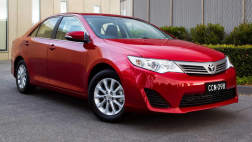Yet the all-new Freelander II is moving on up for 2007, from its styling to a focus on on-road performance and even a cockpit that is far more like a luxury car than a workhorse Land Rover. It is bigger in every direction — longer, wider, taller — and the pay-off is a cabin that is much more roomy as well as providing more luggage space.
The price will also take a Range Rover-style move into the prestige world with a likely starting point around $50,000.
The newcomer definitely takes the Freelander nameplate away from the dowdy original, which was slow, tight inside and outclassed by cheaper Japanese rivals. It was loved in Britain but fell well short of its opponents in the real world, despite impressive off-road ability.
There will be two powerpacks in Freelander II — six-cylinder petrol and four-cylinder turbodiesel, both with an automatic gearbox — and two levels of equipment, with the first local deliveries around the middle of 2007.
It is everything you would expect from a car company that has re-discovered its mojo, with minimal interference from its owners at the Ford Motor Company, and Land Rover Australia is predicting an early sell-out.
It also says Freelander II will take the company into new territory, well above Japanese compact four-wheel drives such as the Toyota RAV4 and Honda CR-V and into a head-to-head contest with the BMW X3, currently priced from $64,900.
But the three-door Freelander is gone and there are no plans for a replacement with less luxury or a tighter price.
"The volume for the three-door was pretty minimal, so it did not go forward," says Roger Jory, the new general manager of Land Rover Australia. "We're not going to do a bargain-basement vehicle. That's not where the brand is going, or what Australian customers want.
"We will have two models, probably a mid-spec car with a lot of standard equipment and then an HSE on top of that."
Jory describes the new Freelander as a "cafe and Kakadu" car and it was previewed to the world's press in Morocco, over a broad mix of country bitumen roads, rocky tracks, sand dunes and beach running.
It handled everything easily, as well as showing off well on luxury equipment including air-conditioning, alloy wheels and satellite navigation, which was specially calibrated for the remote road conditions near the city of Essaouira.
The new Freelander is more than a compact look-alike for the Range Rover. It also drives like the Land Rover flagship, both on and off the road.
It has commendable grip, poise and comfort on the bitumen, and can go everywhere you really need to go in a four-wheel drive. Both engines are punchy and enthusiastic, yet should be relatively light on fuel.
Freelander II will be a success, without any doubt, although the final price will have some impact on the number of Freelander IIs sold in Australia and the suburbs in which they are garaged.
There were a few minor shortcomings on the Morocco test drive, but Land Rover is working on at least two.
It is investigating the unexpected and unprovoked failure of a six-cylinder engine during some sand driving — with a promise from the very top that there will be no repeat in production cars — and installing extra baffling in the rear end to reduce some tyre drumming on coarse bitumen surfaces.
Still, the seats are a little short in leg support and the giant sunroof will need more than net screens to stop serious sunburn in Australia. It was hard to peg expectations for the Freelander II, because the new Land Rovers are so good but the original Freelander was so ... lacklustre.
It hardly mattered, as the new baby was great from the get-go. It accelerated briskly away from the airport and it was much easier to get comfortable, also knowing the luggage space is up by more than one-third. Even the back seat is roomier and more comfortable, with a "theatre-style" layout that puts passengers a little higher for a nicer view.
And the cramped footwell from the original Freelander is finally gone, just like the cheapy dashboard which has been replaced with a classy design with direct links to Range Rover.
There is even good space for the satnav screen, a comfy new steering wheel and clear-and-classy dials and switches.
The inline six, a departure from the usual V6 preferred for compact vehicles, was eager and the turbodiesel also showed plenty of punch. Land Rover says the six will run to 100km/h in 8.4 seconds and the turbodiesel will manage 10.9. There is no reason to doubt the claim, or the way the powerplants deliver at Aussie-speed overtaking runs.
The test drive took the Freelander II over all sorts of roads.
The bitumen was much like home, as were a lot of the dirt roads, until they really got into the rocky ranges.
The big question now is price. If Land Rover Australia can deliver the right deal, the only problem for Freelander II will be keeping up with traffic coming out of showrooms.





.jpg)
.jpg)

.jpg)
_0.jpg)


.jpg)




.jpg)
.jpg)










